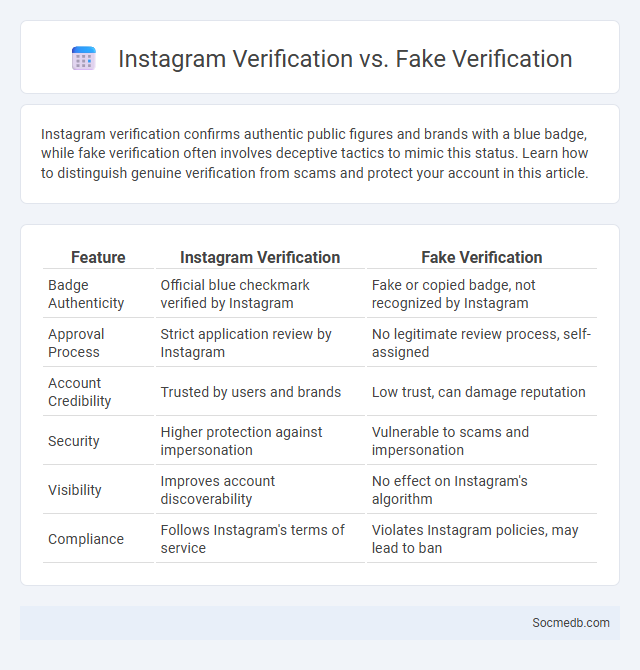
Photo illustration: Instagram Verification vs Fake Verification
Instagram verification confirms authentic public figures and brands with a blue badge, while fake verification often involves deceptive tactics to mimic this status. Learn how to distinguish genuine verification from scams and protect your account in this article.
Table of Comparison
| Feature | Instagram Verification | Fake Verification |
|---|---|---|
| Badge Authenticity | Official blue checkmark verified by Instagram | Fake or copied badge, not recognized by Instagram |
| Approval Process | Strict application review by Instagram | No legitimate review process, self-assigned |
| Account Credibility | Trusted by users and brands | Low trust, can damage reputation |
| Security | Higher protection against impersonation | Vulnerable to scams and impersonation |
| Visibility | Improves account discoverability | No effect on Instagram's algorithm |
| Compliance | Follows Instagram's terms of service | Violates Instagram policies, may lead to ban |
Understanding Instagram Verification
Understanding Instagram verification involves recognizing the platform's criteria for authenticating accounts belonging to public figures, brands, or entities. Your verified badge enhances credibility, increases visibility, and protects against impersonation on Instagram. Meeting requirements such as account authenticity, uniqueness, completeness, and notability is essential to secure the coveted blue checkmark.
What Is Fake Verification on Instagram?
Fake verification on Instagram involves accounts falsely displaying the blue checkmark badge to mimic official or celebrity profiles, misleading users about authenticity. This deceptive practice can undermine your trust in genuine sources and increase the risk of encountering scams or misinformation. Understanding how to spot real verification badges helps protect your account interactions and maintain online security.
The Official Verification Process Explained
The official verification process on social media platforms verifies the authenticity of high-profile accounts to prevent impersonation and enhance user trust. Verification typically requires submitting government-issued identification, proof of notability, and adherence to platform-specific guidelines, ensuring only legitimate accounts receive the coveted blue checkmark. This verification boosts brand credibility, increases visibility in search results, and reduces the risk of misinformation.
Key Differences: Real vs Fake Verification
Fake verification on social media often involves counterfeit badges or symbols that mimic official verification marks, leading to misinformation and reduced credibility. Real verification confirms the authenticity of accounts through platform-specific validation processes, providing users with trust in the legitimacy of content and interactions. Understanding these differences helps protect Your online presence and ensures engagement with credible profiles.
Risks of Fake Instagram Verification
Fake Instagram verification poses significant risks, including compromised account security as scammers exploit fake badges to steal personal information or phish followers. Your online reputation can be severely damaged when impersonators use counterfeit verification to spread misinformation or fraudulent offers. Ensuring you only rely on official Instagram verification protects your digital identity and helps safeguard your social media presence from deceptive schemes.
Benefits of Genuine Instagram Verification
Genuine Instagram verification boosts your credibility by confirming your identity and authenticity, making it easier for your audience to trust your content. This verified status increases visibility and engagement by enabling priority placement in search results and comment sections. Your verified badge also helps protect your brand from impersonators, ensuring that your followers connect with the real you.
Common Scams in Fake Verification
Fake verification scams on social media exploit users by offering counterfeit blue checkmarks or badges in exchange for fees or personal information, leading to identity theft and financial loss. Scammers often impersonate platform officials or use fraudulent websites to lure victims into providing login credentials or payment details. Awareness of official verification processes and skepticism toward unsolicited verification offers can prevent falling victim to these pervasive social media scams.
How to Spot Fake Verification Attempts
Spotting fake verification attempts on social media involves checking for inconsistencies in the verification badge's appearance, such as shape, color, or placement, compared to official platform standards like Twitter's blue checkmark or Instagram's verified badge. Verify the profile's authenticity by examining follower count, recent posts, and engagement patterns to detect automated or suspicious behavior often associated with counterfeit verification. Cross-reference the verified status with third-party sources or the platform's official verification list to confirm legitimacy.
Tips for Securing Real Instagram Verification
You can enhance your chances of securing real Instagram verification by maintaining a consistent and authentic profile with a clear bio, professional photos, and regular posts that showcase your expertise or brand. Prioritize engagement by interacting with followers and other verified accounts to improve credibility and visibility within the Instagram community. Ensuring your account is public and linking to your official website or news articles about you can further validate your authenticity during the verification process.
Conclusion: Protecting Your Instagram Identity
Safeguarding your Instagram identity involves regularly updating passwords, enabling two-factor authentication, and monitoring account activity to prevent unauthorized access. Utilizing privacy settings effectively restricts who can view your content and interact with your profile. Staying vigilant against phishing attempts and avoiding oversharing personal information are essential practices for maintaining control over your digital presence.
 socmedb.com
socmedb.com